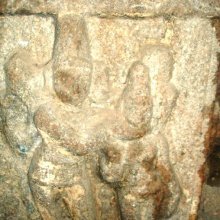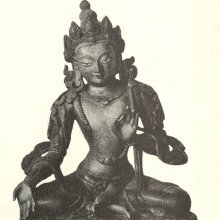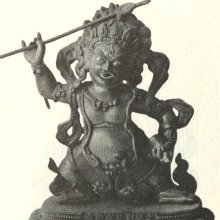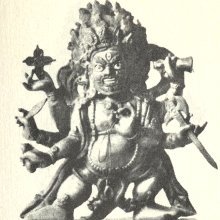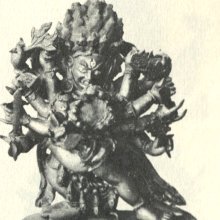Chin: 3 definitions
Introduction:
Chin means something in Hinduism, Sanskrit. If you want to know the exact meaning, history, etymology or English translation of this term then check out the descriptions on this page. Add your comment or reference to a book if you want to contribute to this summary article.
Ambiguity: Although Chin has separate glossary definitions below, it also represents an alternative spelling of the word Cin. It further has the optional forms Chiṇ.
Images (photo gallery)
(+14 more images available)
In Hinduism
Natyashastra (theatrics and dramaturgy)
Source: Shodhganga: Elements of Art and Architecture in the Trtiyakhanda of the Visnudharmottarapurana (natya)The Chin refers to one of the minor Body Parts (belonging to the Face) with which are associated various gestures and expressions (in Sanskrit Dramas), as conveyed through Āṅgikābhinaya: one of the four divisions of Abhinaya or “ways to convey or represent one’s emotion to others”, according to the Nāṭyaśāstra and the Viṣṇudharmottarapurāṇa, an ancient Sanskrit text which (being encyclopedic in nature) deals with a variety of cultural topics such as arts, architecture, music, grammar and astronomy.—The āṅgikābhinaya includes the histrionic representation of the limbs which is simply known as physical gestures. The upāṅgas denote different parts of the Face. These are also six in numbers viz., eyes, eyebrows, nose, lower lip, cheeks and chin.

Natyashastra (नाट्यशास्त्र, nāṭyaśāstra) refers to both the ancient Indian tradition (shastra) of performing arts, (natya—theatrics, drama, dance, music), as well as the name of a Sanskrit work dealing with these subjects. It also teaches the rules for composing Dramatic plays (nataka), construction and performance of Theater, and Poetic works (kavya).
Shilpashastra (iconography)
Source: Shodhganga: Elements of Art and Architecture in the Trtiyakhanda of the Visnudharmottarapurana (shilpa)The Chin is denoted by the Sanskrit term Hanu, and represents one of the various body parts whose Measurements should follow the principles of ancient Indian Painting (citra), according to the Viṣṇudharmottarapurāṇa, an ancient Sanskrit text which (being encyclopedic in nature) deals with a variety of cultural topics such as arts, architecture, music, grammar and astronomy.—In the third part of the Viṣṇudharmottarapurāṇa, chapters 35th to 43rd are dedicated to the Painting of different portraits of different kinds of men and women. The measurement of almost all the body parts that should be maintained in a picture have been presented here. For example, the Chin (hanu) should be 12 aṅgulas.

Shilpashastra (शिल्पशास्त्र, śilpaśāstra) represents the ancient Indian science (shastra) of creative arts (shilpa) such as sculpture, iconography and painting. Closely related to Vastushastra (architecture), they often share the same literature.
Yoga (school of philosophy)
Source: ORA: Amanaska (king of all yogas): A Critical Edition and Annotated Translation by Jason BirchThe Chin (known in Sanskrit as Cibuka) is used in the Lotus Pose as part of Yogic exercises, according to the Dattātreyayogaśāstra verse 35-38ab.—Accordingly, while describing the lotus pose (padmāsana): “[...] Having lifted the uvula with the tongue; having fixed the chin (cibuka) on the chest and having drawn in the breath slowly according to his capacity, he should fill [the region of] the stomach. After that, he should exhale the breath slowly according to his capacity. This is said to be padmāsana, which destroys all diseases”.

Yoga is originally considered a branch of Hindu philosophy (astika), but both ancient and modern Yoga combine the physical, mental and spiritual. Yoga teaches various physical techniques also known as āsanas (postures), used for various purposes (eg., meditation, contemplation, relaxation).
See also (Relevant definitions)
Starts with (+851): Chimdaviya, Chimdisu, Chin chai hua, Chin chan hua, Chin chi lo, Chin feng hua, Chin kang ken, Chin li chih, Chin lien hua, Chin shao yao, Chin ssu tao, Chin ssu tsao, Chin tsan tsao, Chin yin teng, Chin yin tzu, Chin ying tsu, Chin-chine, China, China bean, China berry.
Ends with (+63): Achin, Anushochin, Archin, Arvachin, Asamichin, Ashauchin, Baung-chin, Bwechin, Calauchin, Chan-chin, Chichin, Chih chin, Chokchin, Chu chin, Chyang chin, Chyangchin, Cin, Gangama jachin, Gatrasamkochin, Gatrasankochin.
Full-text (+684): Hanu, Cibuka, Cubuka, Kritavapa, Hanuvati, Hanavati, Civu, Chubuka, Pratyanga, Cukshita, Jambha, Ubbugalla, Chinmudra, Mao chin, Chin'do, Ma-chin, Mu chin, Huang chin, Chin shao yao, Chin kang ken.
Relevant text
Search found 114 books and stories containing Chin, Chiṇ; (plurals include: Chins, Chiṇs). You can also click to the full overview containing English textual excerpts. Below are direct links for the most relevant articles:
Mahabharata (English) (by Kisari Mohan Ganguli)
Section L < [Sisupala-badha Parva]
Section XIX < [Udyoga Parva]
Section CCCXXVI < [Mokshadharma Parva]
I Love Mankind < [October 1968]
Phulwanti < [January – March, 2008]
Sherman Alexies ‘Integration’ Her Vote was Cast < [April – June, 2000]
Animal Kingdom (Tiryak) in Epics (by Saranya P.S)
Chapter 4.17 - The Striped Hyene in the Epics
Chapter 4.14 - The Lion in the Epics
Brahma Sutras (Shankaracharya) (by George Thibaut)
I, 2, 32 < [First Adhyāya, Second Pāda]
I, 2, 31 < [First Adhyāya, Second Pāda]
I, 2, 28 < [First Adhyāya, Second Pāda]
Garga Samhita (English) (by Danavir Goswami)
Verse 3.8.5 < [Chapter 8 - The Opulences of Śrī Girirāja]
Verse 1.13.18 < [Chapter 13 - The Liberation of Pūtanā]
Verse 4.16.7 < [Chapter 16 - The Srī Yamunā Armor]
Rig Veda (translation and commentary) (by H. H. Wilson)
Related products
